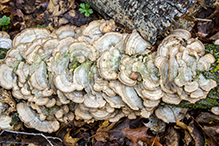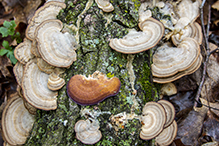Violet-toothed Polypore
(Pallidohirschioporus biformis)
Conservation • Description • Habitat • Ecology • Distribution • Taxonomy
|
|
|||||||||||||
Description |
Violet-toothed Polypore is a common and widespread bracket fungus. It occurs in Europe, western Asia, Australia, South America, and North America. It is one of the most commonly encountered fungi in eastern North America, more common than the seemingly ubiquitous Turkey Tail. It is uncommon in the west and mostly absent from the Great Plains. In Minnesota it is common in the east, uncommon in the northwest, and absent from the southwest. It is found in late spring, summer, and fall, on hardwoods, in deciduous and mixed forests and woodlands. It grows on dead and fallen sticks, branches, and logs, and on stumps. It appears alone or in overlapping clusters, sometimes in a large mass completely covering a rotting log. It obtains its nutrients from dead wood (saprobic). The fruiting body is a ⅜″ to 3″ (1.0 to 7.5 cm) wide, up to ⅛″ (3 mm) thick, shelf-like or bracket-like cap. It is flattened, only slightly convex, and may be fan-shaped, semi-circular, kidney-shaped, or irregular in outline. When it first appears the cap is shades of violet from dark to pale. The violet color soon fades. The mature cap is velvety hairy on the upper side and concentrically zoned with white, grayish-white, and brownish-white. The margin is sometimes pale violet. Older caps may be mostly hairless. The pore surface is pore-like at first, with 2 to 5, violet-colored pores per milliimeter. As it ages it becomes tooth-like and the violet color fades to buff or brown. The violet color fades from the center outward. Mature specimens often retain some violet tints near the margin, or just a thin violet fringe. Older specimens don’t show any trace of violet. The flesh is tough and inedible. |
Similar Species |
Fungus (Pallidohirschioporus subchartaceus) grows only on aspen and poplar. Purplepore Bracket (Trichaptum abietinum) almost always grows on coniferous trees. |
Habitat and Hosts |
Deciduous and mixed forests and woodlands. Hardwoods. |
Ecology |
Season |
Late spring, summer, and fall |
Distribution |
||
|
Sources |
|
| 9/22/2024 | ||
Occurrence |
||
Common in Minnesota |
||
Taxonomy |
|
Kingdom |
Fungi (Fungi) |
Subkingdom |
Dikarya |
Phylum |
Basidiomycota (Basidiomycete Fungi) |
Subphylum |
Agaricomycotina (Higher Basidiomycetes) |
Class |
Agaricomycetes (Mushrooms, Bracket Fungi, Puffballs, and Allies) |
No Rank |
Agaricomycetes incertae sedis (no subclass) |
Order |
Hymenochaetales |
Family |
Hirschioporaceae |
Genus |
Pallidohirschioporus |
This species was first described as Polyporus biformis by Elias Magnus Fries in 1833. It was placed in the family Polyporaceae in the order Polyporales. In 1972 Miles Joseph Berkeley transferred it into the genus Trichaptum in the order Hymenochaetales, and it became Trichaptum biforme. Trichaptum and several other genera in the Hymenochaetales were incertae sedis (“uncertain placement”), and they were not placed in a family. The genus Trichaptum contained species that were derived from more than one common ancestor (polyphyletic), and it was therefore invalid. A very recent morphological and molecular study (Zhou M et al., 2023) proposed a revised systematics of Trichaptum s. l.. Two new families and five new genera were proposed. Ten species were transferred into the new genus Pallidohirschioporus and the new family Hirschioporaceae. Pallidohirschioporus biformis became the type species of the genus Pallidohirschioporus. The proposed move has not been widely accepted – yet. This is probably in large part to the newness of the study, which was published in August 2023. Index Fungorum, MycoBank, NCBI, and Catalog of Life have adopted the new systematics. |
|
Subordinate Taxa |
|
|
|
Synonyms |
|
Coriolus biformis Hirschioporus friesii Hirschioporus pergamenus Microporellus friesii Polyporus biformis Polyporus elongatus Polyporus laceratus Polyporus pergamenus Polyporus xalapensis Trametes biformis Trichaptum biforme |
|
Common Names |
|
Violet-toothed Bracket Fungus Violet-toothed Polypore |
|
Glossary
Saprobic
A term often used for saprotrophic fungi. Referring to fungi that obtain their nutrients from decayed organic matter.
Visitor Photos |
||
Share your photo of this fungus. |
||
This button not working for you? |
||
Paul |
||
 |
||
Luciearl |
||
 |
 |
|
 |
 |
|
MinnesotaSeasons.com Photos |
||
 |
 |
|
 |
 |
|
 |
 |
|
 |
 |

Slideshows |
|

Visitor Videos |
||
Share your video of this fungus. |
||
This button not working for you? |
||
Honey Fae (Farah) |
Violet toothed Polypore 01 |
About
Violet-toothed Polypore (Trichaptum biforme) |
Violet toothed Polypore 02 |
About
Violet-toothed Polypore (Trichaptum biforme) |
Other Videos |
||
Trichaptum biforme (Violet toothed polypore) |
About
Jun 21, 2020 Key Disease and Pest Video Compendium 2 Plant Pathology 5060 at OSU |
Trichaptum Biforme "Purple Tooth" Fungus |
About
Nov 26, 2013 Interesting... |
Trichaptum biforme is a species of fungus which decompose hardwood |
About
Apr 23, 2017 |
Polypore Fungi (Trichaptum biforme) on Tree Trunk |
About
Apr 23, 2011 Photographed at the Turtle River State Park, North Dakota (23 April 2010). |

Visitor Sightings |
||
Report a sighting of this fungus. |
||
This button not working for you? |
||
| Luciearl January 2024 |
Location: Fairview Twp, Cass Co. |
 |
Honey Fae (Farah) |
Location: Hennepin County |
|
| Luciearl 7/21/2020 |
Location: Cass County |
 |
MinnesotaSeasons.com Sightings |
||

Created: 12/22/2020 Last Updated: © MinnesotaSeasons.com. All rights reserved. |
